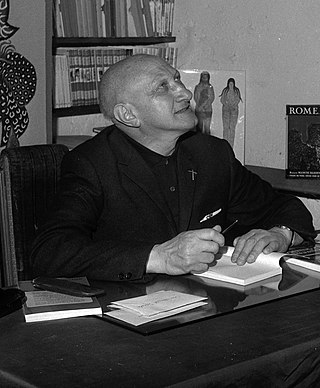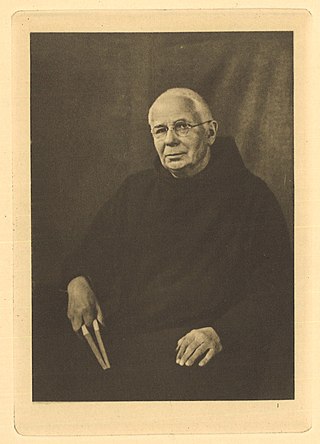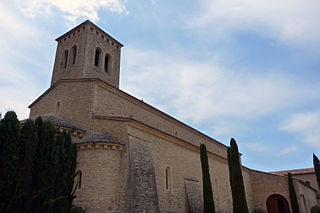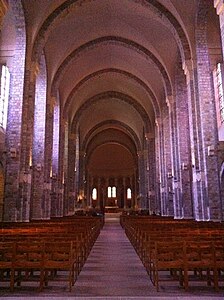
The Benedictines, officially the Order of Saint Benedict, are a mainly contemplative monastic religious order of the Catholic Church for men and for women who follow the Rule of Saint Benedict. The male religious are also sometimes called the Black Monks, in reference to the colour of their religious habits, in contrast to other Benedictine orders such as the Olivetans, who wear white. They were founded in 529 by Benedict of Nursia, a 6th-century Italian monk who laid the foundations of Benedictine monasticism through the formulation of his Rule. Benedict's sister, Scholastica, possibly his twin, also became a religious from an early age, but chose to live as a hermit. They retained a close relationship until her death.

Lérins Abbey is a Cistercian monastery on the island of Saint-Honorat, one of the Lérins Islands, on the French Riviera, with an active monastic community.

Lambert Beauduin OSB was a Belgian monk who founded the monastery now known as Chevetogne Abbey in 1925. He was a leading member of the Belgian liturgical movement and a pioneer of the European liturgical revival.

Fleury Abbey (Floriacum) in Saint-Benoît-sur-Loire, Loiret, France, founded in about 640, is one of the most celebrated Benedictine monasteries of Western Europe, and possesses the relics of St. Benedict of Nursia. Its site on the banks of the Loire has always made it easily accessible from Orléans, a center of culture unbroken since Roman times. In 2010, the abbey had over forty monks led by the abbot Etienne Ricaud.

Ligugé Abbey, formally called the Abbey of St. Martin of Ligugé, is a French Benedictine monastery in the Commune of Ligugé, located in the Department of Vienne. Dating to the 4th century, it is the site of one of the earliest monastic foundations in France. The original abbey having been destroyed during the French Revolution, the current monastic community dates from 1853, and belongs to the Solesmes Congregation.

Solesmes Abbey or St. Peter's Abbey, Solesmes is a Benedictine monastery in Solesmes, Sarthe, France, famous as the source of the restoration of Benedictine monastic life in the country under Dom Prosper Guéranger after the French Revolution. The current abbot is the Right Reverend Dom Abbot Geoffrey Kemlin, O.S.B., elected in 2022.

The Roman Catholic Archdiocese of Rabat is an ecclesiastical territory or diocese of the Roman Catholic Church in Morocco. It was erected as the Apostolic Vicariate of Rabat on July 2, 1923, by Pope Pius XI, and promoted to the rank of an archdiocese by Pope Pius XII on September 14, 1955.

Maxime Jacob, or Dom Clément Jacob, was a French composer and organist.

Vaux-de-Cernay Abbey was a Cistercian monastery in northern France (Île-de-France), situated in Cernay-la-Ville, in the Diocese of Versailles, Yvelines.

Glanfeuil Abbey, otherwise the Abbey of St Maurus, was a French Benedictine monastery founded in the 9th century in the village of Saint-Maur-sur-Loire, located in what is now the commune of Le Thoureil, Maine-et-Loire.
The Subiaco Cassinese Congregation is an international union of Benedictine houses within the Benedictine Confederation. It developed from the Subiaco Congregation, which was formed in 1867 through the initiative of Dom Pietro Casaretto, O.S.B., as a reform of the way of life of monasteries of the Cassinese Congregation, formed in 1408, toward a stricter contemplative observance, and received final approval in 1872 by Pope Pius IX. After discussions between the two congregations at the start of the 21st century, approval was given by Pope Benedict XVI in 2013 for the incorporation of the Cassinese Congregation into its offshoot, the Subiaco Congregation. The expanded congregation was given this new name.
Abbaye Saint-Benoît de Koubri, Koubri, Kadiogo Province, Burkina Faso, is a Benedictine monastery of the Subiaco Congregation. Founded in 1961, the monastery is located around 30 km from Ouagadougou, the capital of Burkina Faso. As of 2000, the monastery was home to 27 monks, under the leadership of Abbot Fr André Ouédraogo.
Abbaye de l'Ascension, Dzogbégan, Plateaux Region, Togo, is a Benedictine monastery of the Subiaco Cassinese Benedictine Congregation. Founded by French monks in 1961, the monastery was elevated to abbatial status in 1991. As of 2022, the monastery was home to thirty monks, under the leadership of Abbot Fr Theodore Kouassis Coco who is the second abbot of the monastic community.

Moutiers-Saint-Jean Abbey was a monastery located in what is now the village of Moutiers-Saint-Jean in the Côte-d'Or department in eastern France. It is in Burgundy, near Dijon.

Ursmer Berlière, born Alfred Berlière (1861–1932) was a monk of Maredsous Abbey and a monastic historian whose bibliography ran to 360 publications.

The abbey of Sainte-Madeleine du Barroux also known as Le Barroux Abbey is a traditionalist Benedictine abbey located in Le Barroux, Vaucluse, France. It was founded in 1978 by Dom Gérard Calvet while the current abbot is Dom Louis-Marie de Geyer d’Orth.
Relations between the Catholic Church and Islam deals with the current attitude of the Catholic Church towards Islam, as well as the attitude of Islam towards the Catholic Church and Catholics, and notable changes in the relationship since the 20th century.
Thierry de Brunhoff is a French pianist and Benedictine monk.

The Monastery of Toumliline was a Benedictine monastery in Toumliline, Morocco. It was the only Benedictine monastery in Morocco and hosted the International Meetings, an annual interfaith conference.


















